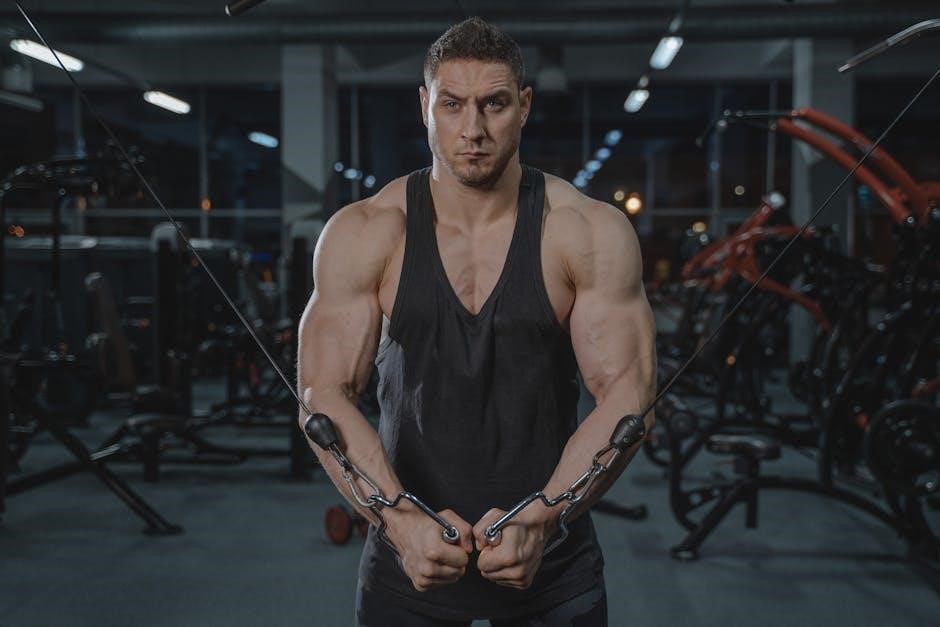A well-structured chest and triceps workout is essential for building strength and achieving a balanced physique. This 8-week routine provides a comprehensive guide to target these muscle groups effectively, ensuring progressive overload and consistent growth. By incorporating exercises like incline presses and tricep dips, you’ll enhance both muscle size and overall athletic performance.
1.1 Importance of Chest and Triceps Workouts
Chest and triceps workouts are crucial for building upper body strength and enhancing muscle mass. The chest muscles, including the pectoralis major and minor, play a key role in movements like pushing and throwing, while the triceps contribute to arm extension and stability. Strengthening these muscles improves overall athletic performance and posture. Additionally, well-developed chest and triceps enhance aesthetic appeal and contribute to a balanced physique, making them a cornerstone of effective training routines.
1.2 Benefits of a Structured Workout Plan
A structured workout plan ensures consistency and progression, maximizing chest and triceps development. Organized routines prevent overtraining and injury, while optimizing time and effort. By following a clear schedule, you can systematically increase intensity and volume, leading to steady muscle growth and strength gains. This approach also helps maintain accountability, making it easier to track progress and achieve long-term fitness goals effectively.
1.3 Overview of the 8-Week Workout Routine
This 8-week chest and triceps program is designed to enhance muscle growth and strength through targeted exercises. Each week introduces progressive overload, with increasing weights and volume. The routine includes essential movements like incline presses, cable flyes, and tricep dips, structured to maximize hypertrophy. By following this plan, you’ll achieve a balanced chest and defined triceps, with visible results in just two months of consistent training and proper nutrition.

Understanding the Muscles
The chest muscles, including the pectoralis major and minor, and triceps brachii, are crucial for pushing movements. Secondary muscles like shoulders and lats also contribute to overall strength.
2.1 Chest Muscles (Pectoralis Major and Minor)
The pectoralis major is the larger chest muscle responsible for movements like pushing and flexion. The pectoralis minor, situated beneath, aids in scapular rotation and forward arm movement. Together, they contribute to a broader chest and overall upper-body stability, making them key targets in exercises like bench presses and incline flyes for enhanced muscle development and strength.
2.2 Triceps Muscles (Triceps Brachii)
The triceps brachii, located on the back of the upper arm, consists of three heads: lateral, medial, and long. It is crucial for elbow extension and stabilizes the shoulder joint during movements. Strengthening the triceps enhances pushing power and overall arm aesthetics, making exercises like skull crushers and tricep dips essential for a balanced and powerful upper-body workout routine.
2.3 Secondary Muscles Involved
Secondary muscles, such as the shoulders, core, and upper back, play a vital role in chest and triceps exercises. The anterior deltoids assist during presses, while the core stabilizes the body. The upper back muscles, like the trapezius, help maintain proper form. Strengthening these secondary muscles enhances overall performance, prevents injury, and contributes to a more balanced physique, making them integral to a successful workout routine.

Warm-Up and Preparation
A proper warm-up includes light cardio, dynamic stretches, and joint mobilization to prepare the chest, shoulders, and triceps for intense training, ensuring flexibility and reducing injury risk.
3.1 Essential Warm-Up Exercises
A dynamic warm-up is crucial to prepare the chest and triceps for training. Start with 5-10 minutes of light cardio, such as treadmill or cycling, to increase blood flow. Follow with arm circles, chest opens, and tricep stretches to improve flexibility and range of motion. Incorporate dumbbell presses or light resistance to activate the muscles without fatigue. Finish with joint mobilization exercises to ensure proper movement and reduce injury risk before diving into the workout.
- Arm circles: Enhances shoulder mobility and warms up the triceps.
- Chest opens: Expands chest flexibility and prepares the pectoralis muscles.
- Tricep stretches: Targets the triceps brachii for optimal movement.
Keep the warm-up concise yet thorough to transition smoothly into the workout routine.
3.2 Setting Up Your Workout Environment
Creating an organized workout environment is key to maximizing efficiency and safety. Ensure your space is clean and well-lit, with all necessary equipment within easy reach. Position benches and cables appropriately to avoid obstacles. Maintain a consistent temperature to prevent overheating and keep a water bottle nearby for hydration. Minimize distractions by organizing your weights and resistance bands neatly. A clutter-free and focused environment will help you stay motivated and maintain proper form throughout your workout.
- Position equipment strategically for easy access.
- Ensure proper lighting for clear visibility.
- Organize weights and cables to prevent tripping hazards.
A well-prepared environment sets the foundation for a productive and injury-free workout session.
Chest Exercises
Target your chest with exercises like incline dumbbell bench presses, flat bench presses, and pec deck flies to build strength and definition. These movements effectively engage the pectoral muscles, promoting overall chest development and improving upper body stability.
4.1 Incline Dumbbell Bench Press
The incline dumbbell bench press targets the upper chest muscles, enhancing definition and strength. Sit on a 30-45 degree incline bench, hold dumbbells over your chest, and press upwards, extending your arms fully. Lower the weights slowly to the starting position, focusing on controlled movement. This exercise is crucial for balanced chest development and pairs well with flat bench presses for a comprehensive workout routine.
4.2 Flat Dumbbell Bench Press
The flat dumbbell bench press is a fundamental exercise for building chest strength and size. Lie on a flat bench, gripping dumbbells tightly, and press them upwards until your arms are fully extended. Lower the weights slowly to your chest, maintaining control throughout the movement. This exercise effectively targets the pectoralis major, promoting muscle growth and overall chest development when incorporated into your workout routine.
4.3 Pec Deck Fly
The pec deck fly is an isolation exercise targeting the pectoralis major muscles. Sit at the machine with your chest pressed against the pad and grip the handles. Squeeze your chest to push the handles outward, then slowly return to the starting position. This exercise is effective for adding width to the chest and can be incorporated into your routine for varied chest development. Focus on controlled movement to maximize chest engagement and avoid shoulder strain.
4.4 High to Low Cable Fly
The high-to-low cable fly targets the lower chest muscles, enhancing definition and width. Stand facing a cable machine with cables at shoulder height. Hold the handles and press them downward toward your thighs, keeping your arms slightly bent. Focus on squeezing your chest at the bottom of the movement before returning to the starting position. This exercise helps create a fuller chest and improves overall upper body symmetry when performed consistently.

Triceps Exercises
Targeting the triceps with exercises like skull crushers, tricep dips, and lying extensions builds strength and definition. These movements effectively engage the triceps from multiple angles, ensuring balanced development and a more muscular upper arm appearance.
5.1 Skull Crushers
Skull crushers are a highly effective exercise for targeting the triceps, particularly the lateral and medial heads. Lie on a flat bench, hold an EZ bar or dumbbells over your chest, and lower the weight behind your head by bending your elbows. Keep your upper arms still and focus on controlled movements to maximize tricep engagement. This exercise is excellent for building thickness and strength in the triceps.
5.2 Tricep Dips
Tricep dips are a versatile and effective exercise for targeting the triceps, particularly the lateral and medial heads. Perform them on a bench or parallel bars by lowering your body until your elbows bend at 90 degrees, then straighten your arms to return to the starting position. Keep your core engaged and avoid swinging to maintain proper form. This exercise is excellent for building both size and strength in the triceps.
5.3 Lying Tricep Extension
The lying tricep extension targets the triceps brachii, focusing on both the length and thickness of the muscle. Lie on a flat bench and hold a barbell or dumbbells over your chest. Lower the weight behind your head by bending your elbows, then extend your arms fully to return to the starting position. This exercise is ideal for isolating the triceps and promoting significant hypertrophy when performed with controlled movements.
5.4 Overhead Arm Extension
The overhead arm extension is a versatile tricep exercise that can be performed with dumbbells or a cable rope. Stand tall, holding the weight overhead with your arms extended. Lower the weight behind your head by bending your elbows, keeping your upper arms still. This exercise effectively targets the triceps from a different angle, enhancing both strength and flexibility. It’s a great finisher to exhaust the triceps after heavier lifts.

Workout Structure
A structured workout plan ensures efficient targeting of chest and triceps. Split routines, supersets, and circuits maximize time while allowing adequate rest for muscle recovery and growth.
6.1 Split Routine (Push/Pull/Legs)
A Push/Pull/Legs split is an effective way to organize workouts, dedicating days to specific muscle groups. For chest and triceps, this includes exercises like bench presses and dips. This structure allows for focused training, ensuring each muscle group is adequately targeted while enabling sufficient recovery time. It helps maintain consistency and prevents overtraining, making it ideal for both beginners and advanced lifters aiming for balanced development.
6.2 Superset and Circuit Training
Superset and circuit training are excellent for enhancing workout efficiency and intensity. Supersets involve performing two exercises back-to-back without rest, ideal for targeting chest and triceps. For example, pairing bench presses with tricep dips maximizes time and boosts muscle engagement. Circuit training extends this concept by linking multiple exercises in a sequence, promoting endurance and calorie burn. These methods keep workouts dynamic and challenging, ensuring consistent progress and improved overall fitness.
6.3 Rest and Recovery Between Sets
Proper rest and recovery between sets are crucial for optimal muscle growth and performance. Allow 60-90 seconds of rest after each set to replenish energy stores and maintain intensity. Longer breaks may be needed for heavier lifts to ensure proper form and safety. Consistent recovery habits prevent fatigue and injury, enabling you to train effectively throughout the 8-week program and achieve desired results in chest and triceps development.
Progressive Overload
Progressive overload is key to muscle growth, achieved by gradually increasing weight or reps. This ensures continuous challenge and development in chest and triceps workouts.
7.1 Increasing Weight
Increasing weight is a cornerstone of progressive overload, essential for muscle growth. Start with manageable loads and gradually add weight each week. Focus on compound exercises like bench presses and skull crushers, aiming to lift heavier dumbbells or barbells. Maintain proper form to prevent injury. Consistency is key—challenge yourself weekly to ensure continuous progress in chest and triceps development. This method ensures muscles remain stimulated, promoting strength and size gains effectively.
7.2 Increasing Volume (Sets/Reps)
Increase workout volume by adding more sets or reps weekly to challenge muscles. For chest, aim for 4-5 sets of 8-12 reps on exercises like incline bench presses. For triceps, add reps to dips or skull crushers, targeting 3-4 sets of 10-15 reps. Gradually increase reps by 2-3 each week or add an extra set. This approach ensures continuous muscle stimulation and growth, while maintaining proper form to avoid injury. Adjust based on fitness level for optimal results.
7.3 Adjusting Rest Time
Rest time between sets is crucial for recovery and performance. For chest exercises, rest 60-90 seconds between sets to maintain strength and endurance. Triceps exercises require similar rest periods, ensuring proper recovery. Gradually reduce rest time as fitness improves to increase workout intensity. Adjustments should balance recovery with efficiency, allowing muscles to rebuild while enhancing overall workout effectiveness. Consistent management of rest time optimizes muscle growth and strength gains throughout the routine. Maintain focus and discipline during these intervals for maximum results. Always prioritize quality recovery to prevent overtraining and injury risks. Stay consistent with rest periods to support progressive overload and muscle development. Adjustments should align with individual goals, whether focusing on strength or endurance. Proper rest time management is key to achieving a balanced and effective workout routine. Keep rest periods consistent to ensure steady progress and avoid plateaus. Effective rest management enhances workout efficiency and supports overall muscle growth and strength. Always adapt rest time based on current fitness levels and goals. This ensures workouts remain challenging and effective, promoting continuous improvement. Adequate rest supports muscle recovery, enabling harder training sessions and better results. Adjust rest time wisely to maximize the effectiveness of each workout. Stay disciplined with rest periods to achieve the best possible outcomes in chest and triceps development. Consistency in rest time management is vital for sustained progress and muscle growth. Properly timed rest periods enhance workout performance and support long-term goals; Manage rest time effectively to optimize muscle recovery and growth, ensuring each workout contributes to overall success. Adjust rest time as needed to maintain intensity and promote continuous improvement. Rest periods should align with workout intensity and individual recovery needs. Always prioritize recovery to sustain progress and avoid setbacks. Effective rest time management is essential for achieving the desired results in any workout routine. Adjust rest periods to suit fitness levels and goals, ensuring each workout is productive and recovery-oriented. Stay focused on maintaining proper rest time to support muscle growth and strength gains. Consistent rest management enhances workout efficiency and supports overall success. Always adapt rest time to meet the demands of the workout and individual recovery needs. This ensures optimal progress and keeps workouts effective and engaging. Proper rest time management is a cornerstone of successful muscle development and strength training. Adjust rest periods to maintain workout intensity and support continuous growth. Effective rest management is crucial for achieving the best results in chest and triceps workouts. Consistency and adaptability in rest time ensure sustained progress and muscle development. Always prioritize recovery through well-timed rest periods to maximize workout effectiveness. Adjust rest time as needed to support individual goals and fitness levels. Proper rest management enhances workout performance and supports long-term success. Stay disciplined with rest periods to achieve optimal muscle growth and strength. Adjust rest time effectively to maintain workout intensity and promote continuous improvement. Rest periods should be tailored to individual recovery needs and workout goals. Always ensure adequate rest to prevent overtraining and support muscle recovery. Effective rest time management is essential for achieving the best possible results in any workout routine. Adjust rest periods to suit workout demands and individual needs, ensuring each session is productive and recovery-focused. Stay consistent with rest management to support muscle growth and strength gains. Proper rest time enhances workout efficiency and overall success. Always adapt rest periods to meet the challenges of the workout and support recovery. This ensures steady progress and keeps workouts engaging and effective. Rest time management is vital for optimizing muscle development and achieving fitness goals. Adjust rest periods to maintain intensity and support continuous growth. Effective rest management supports workout performance and long-term success. Consistency in rest time ensures sustained progress and muscle development. Always prioritize recovery through well-timed rest periods to maximize workout effectiveness. Adjust rest time as needed to align with individual goals and fitness levels. Proper rest management enhances workout performance and supports overall success. Stay focused on maintaining adequate rest to prevent overtraining and support muscle recovery. Adjust rest periods to suit workout intensity and individual needs, ensuring each session contributes to progress. Effective rest time management is crucial for achieving the best results in chest and triceps workouts. Consistency and adaptability ensure sustained growth and workout effectiveness. Always ensure rest periods are optimized for recovery and performance. Adjust rest time to meet the demands of the workout and support individual goals. Proper rest management enhances efficiency and supports long-term success. Stay disciplined with rest periods to achieve optimal muscle development. Adjust rest time effectively to maintain intensity and promote continuous improvement. Rest periods should align with workout goals and recovery needs. Always prioritize recovery to sustain progress and avoid setbacks. Effective rest time management ensures workouts remain productive and recovery-oriented. Adjust rest periods to suit fitness levels and workout demands, ensuring each session is effective. Stay consistent with rest management to support muscle growth and strength gains. Proper rest time enhances workout performance and overall success. Always adapt rest periods to meet individual needs and workout intensity. This ensures steady progress and keeps workouts engaging. Rest time management is essential for optimizing muscle development and achieving fitness goals. Adjust rest periods to maintain workout intensity and support continuous growth. Effective rest management supports workout performance and long-term success. Consistency in rest time ensures sustained progress and muscle development. Always prioritize recovery through well-timed rest periods to maximize effectiveness. Adjust rest time as needed to align with goals and fitness levels. Proper rest management enhances workout efficiency and supports overall success. Stay focused on maintaining adequate rest to prevent overtraining and support recovery. Adjust rest periods to suit workout demands and individual needs, ensuring each session contributes to progress. Effective rest time management is crucial for achieving the best results. Consistency and adaptability ensure sustained growth and effectiveness. Always ensure rest periods are optimized for recovery and performance. Adjust rest time to meet workout demands and support individual goals. Proper rest management enhances efficiency and supports long-term success. Stay disciplined with rest periods to achieve optimal development. Adjust rest time effectively to maintain intensity and promote improvement. Rest periods should align with goals and recovery needs. Always prioritize recovery to sustain progress. Effective rest management ensures productive workouts. Adjust rest periods to suit fitness levels and demands, ensuring effectiveness. Stay consistent with rest management to support growth and gains. Proper rest time enhances performance and success. Always adapt rest periods to meet individual needs and intensity. This ensures steady progress. Rest time management is essential for optimizing development and achieving goals. Adjust rest periods to maintain intensity and support growth. Effective rest management supports performance and success. Consistency ensures sustained progress. Always prioritize recovery through rest. Adjust rest time to meet demands and goals. Proper rest management enhances efficiency and success. Stay disciplined with rest periods for optimal development. Adjust rest time effectively to maintain intensity. Rest periods should align with goals and recovery. Always prioritize recovery. Effective rest management ensures productivity. Adjust rest periods to suit needs and demands. Stay consistent for growth and gains. Proper rest enhances performance. Always adapt rest periods. This ensures progress. Rest management is essential. Adjust periods to maintain intensity. Effective management supports success. Consistency ensures progress. Prioritize recovery. Adjust rest time. Proper management enhances efficiency. Stay disciplined. Adjust rest. Align with goals. Ensure productivity. Suit needs. Stay consistent. Enhance performance. Adapt rest. Ensure progress. Manage rest. Maintain intensity. Support success. Ensure consistency. Prioritize recovery. Adjust rest. Enhance efficiency. Stay disciplined. Align rest. Ensure productivity. Suit needs. Stay consistent. Enhance performance. Adapt rest. Ensure progress. Manage rest. Maintain intensity. Support success. Ensure consistency. Prioritize recovery. Adjust rest. Enhance efficiency. Stay disciplined. Align rest. Ensure productivity. Suit needs. Stay consistent. Enhance performance. Adapt rest. Ensure progress. Manage rest. Maintain intensity. Support success. Ensure consistency. Prioritize recovery. Adjust rest. Enhance efficiency. Stay disciplined. Align rest. Ensure productivity. Suit needs. Stay consistent. Enhance performance. Adapt rest. Ensure progress. Manage rest. Maintain intensity. Support success. Ensure consistency. Prioritize recovery. Adjust rest. Enhance efficiency. Stay disciplined. Align rest. Ensure productivity. Suit needs. Stay consistent. Enhance performance. Adapt rest. Ensure progress. Manage rest. Maintain intensity. Support success. Ensure consistency. Prioritize recovery. Adjust rest. Enhance efficiency. Stay disciplined. Align rest. Ensure productivity. Suit needs. Stay consistent. Enhance performance. Adapt rest. Ensure progress. Manage rest. Maintain intensity. Support success. Ensure consistency. Prioritize recovery. Adjust rest. Enhance efficiency. Stay disciplined. Align rest. Ensure productivity. Suit needs. Stay consistent. Enhance performance. Adapt rest. Ensure progress. Manage rest. Maintain intensity. Support success. Ensure consistency. Prioritize recovery. Adjust rest. Enhance efficiency. Stay disciplined. Align rest; Ensure productivity. Suit needs. Stay consistent. Enhance performance. Adapt rest. Ensure progress. Manage rest. Maintain intensity. Support success. Ensure consistency. Prioritize recovery. Adjust rest. Enhance efficiency. Stay disciplined. Align rest. Ensure productivity. Suit needs. Stay consistent. Enhance performance. Adapt rest. Ensure progress. Manage rest. Maintain intensity. Support success. Ensure consistency. Prioritize recovery. Adjust rest. Enhance efficiency. Stay disciplined. Align rest. Ensure productivity. Suit needs. Stay consistent. Enhance performance. Adapt rest. Ensure progress. Manage rest. Maintain intensity. Support success. Ensure consistency. Prioritize recovery. Adjust rest. Enhance efficiency. Stay disciplined. Align rest. Ensure productivity. Suit needs. Stay consistent. Enhance performance. Adapt rest. Ensure progress. Manage rest. Maintain intensity. Support success. Ensure consistency. Prioritize recovery. Adjust rest. Enhance efficiency. Stay disciplined. Align rest. Ensure productivity. Suit needs. Stay consistent. Enhance performance. Adapt rest. Ensure progress. Manage rest. Maintain intensity. Support success. Ensure consistency. Prioritize recovery. Adjust rest. Enhance efficiency. Stay disciplined. Align rest. Ensure productivity. Suit needs. Stay consistent. Enhance performance. Adapt rest. Ensure progress. Manage rest. Maintain intensity. Support success. Ensure consistency. Prioritize recovery. Adjust rest. Enhance efficiency. Stay disciplined. Align rest. Ensure productivity. Suit needs

Nutrition and Supplementation
Adequate nutrition is vital for muscle growth and recovery. Ensure high protein intake, balanced with complex carbs and healthy fats. Consider whey protein, creatine, and BCAAs for optimal results.
8.1 Protein Intake for Muscle Growth
Adequate protein intake is crucial for muscle repair and growth. Aim for 1.2-2.2 grams of protein per kilogram of body weight daily. Sources like lean meats, fish, eggs, and whey protein are ideal. Timing is key—consume protein within an hour post-workout to maximize recovery. Additionally, distribute protein evenly across meals to maintain muscle synthesis throughout the day, supporting chest and triceps development effectively.
8.2 Carbohydrates for Energy
Carbohydrates are the primary energy source for intense workouts. Consume complex carbs like whole grains, fruits, and vegetables before training to fuel performance. Post-workout, simple carbs such as bananas or sports drinks help replenish glycogen stores. Aim for 2-3 grams of carbs per kilogram of body weight daily, balancing intake around workouts to sustain energy and support muscle recovery, ensuring optimal performance during chest and triceps exercises.
8.3 Healthy Fats and Supplements
Healthy fats, such as avocados, nuts, and olive oil, support hormone production and overall health. Essential fatty acids aid in muscle recovery and inflammation reduction. Consider adding supplements like fish oil and creatine to enhance workout performance and muscle growth. A multivitamin ensures nutrient deficiencies are covered, while protein powder supports muscle repair and growth, helping you maximize the benefits of your chest and triceps training routine effectively.

Recovery and Rest
Recovery is crucial for muscle repair and growth. Ensure adequate sleep, incorporate stretching, and stay hydrated to optimize results and prevent overtraining, enhancing overall performance.
9.1 Importance of Sleep
Sleep is vital for muscle recovery and growth. During rest, your body repairs and strengthens chest and triceps muscles. Aim for 7-9 hours nightly to optimize recovery. Poor sleep hinders progress, while quality sleep boosts performance. Ensure a dark, cool environment for better rest. Consistency in sleep schedules enhances recovery, making it a cornerstone of your workout success.
9.2 Active Recovery Techniques
Active recovery, such as light cardio or stretching, enhances blood flow and reduces muscle soreness. Techniques like yoga, swimming, or low-intensity cycling promote relaxation and flexibility without straining chest and triceps. Foam rolling and dynamic stretches can also aid in muscle repair and improve mobility. Incorporating these methods between workouts supports overall recovery, ensuring your body is prepared for the next training session.
9.3 Foam Rolling and Stretching
Foam rolling and stretching are crucial for post-workout recovery, targeting the chest and triceps. Foam rolling improves circulation, reduces muscle tension, and enhances flexibility. Gentle stretches like chest opens and tricep extensions help maintain mobility and prevent tightness. Regular stretching promotes better posture and reduces injury risk, ensuring optimal muscle function for future workouts. Consistency in these practices supports overall recovery and muscle health.

Accessory Exercises
Shoulder exercises like lateral raises and front raises enhance stability, while core workouts such as planks and Russian twists build a stronger base for overall strength and posture.
10.1 Shoulder Exercises for Stability
Shoulder exercises like lateral raises, front raises, and face pulls are crucial for stability and preventing injuries. These movements strengthen the deltoids and rotator cuff muscles, improving posture and overall athletic performance. Incorporating these into your routine enhances shoulder health, allowing for heavier chest and tricep workouts without strain. Consistency in these exercises ensures long-term shoulder stability and better overall upper body development.
10.2 Core Exercises for a Stronger Base
Core exercises like planks, Russian twists, and leg raises are essential for building a strong, stable base. These movements target the abs, obliques, and lower back, improving posture and reducing injury risk. A strong core enhances overall athletic performance and supports heavier chest and tricep workouts; Incorporating these exercises into your routine promotes better balance, stability, and long-term muscle development, making them a vital addition to your workout plan.

Mental Preparation and Motivation
Mental preparation and motivation are crucial for consistency and success in your workout journey. Setting realistic goals and tracking progress helps maintain focus and drive, ensuring long-term commitment to your chest and triceps routine.
11.1 Setting Realistic Goals
Setting realistic goals is essential for staying motivated and tracking progress in your chest and triceps workout. Break your objectives into short-term milestones, such as increasing bench press weight or completing a set of tricep dips without assistance. Celebrate small achievements to maintain momentum and adjust goals as you progress. A clear, achievable plan helps build confidence and keeps you committed to your fitness journey.
11.2 Tracking Progress
Tracking progress is crucial to ensure your chest and triceps workout remains effective. Use a workout log to record weights, reps, and sets, allowing you to monitor improvements over time. Take progress photos and measurements to visualize changes in muscle growth. Adjust your routine based on results, ensuring continuous improvement and staying motivated throughout your fitness journey.
11.3 Staying Consistent
Consistency is key to achieving results in your chest and triceps workout. Stick to your routine, avoiding missed sessions, and maintain a disciplined approach. Schedule workouts in advance and use a downloadable PDF plan to stay on track. Regular training fosters muscle growth and strength. Track progress and adjust as needed, ensuring long-term commitment to your fitness goals for sustained success.

Sample Workout PDF
Download the free 8-week chest and triceps workout plan in PDF format. This organized guide includes exercises, sets, reps, and nutritional advice for optimal results.
12.1 Downloadable 8-Week Plan
Access a detailed 8-week chest and triceps workout plan in PDF format. This downloadable guide includes structured exercises, sets, reps, and warm-up routines. Designed for progressive overload, it features exercises like incline presses and skull crushers. Nutritional advice and recovery tips are also included to maximize results. Perfect for both beginners and experienced lifters, this plan can be printed or saved digitally for easy tracking and motivation throughout your fitness journey.
